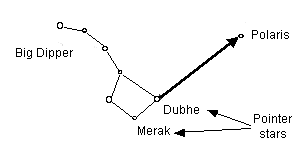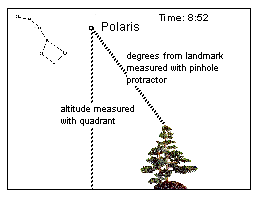
Altitude & position of Polaris using the quadrant & pinhole protractor
1. First locate Polaris. Looking to the north, locate the Big Dipper. Follow the pointer stars as shown below in a straight line to Polaris which is about 2.5 fist-widths (holding your fist at arm’s length) from the Dipper. Polaris is not a very bright star so this is the best way to find it.

2. Hold your quadrant so that 90o is closer to you (see previous digram of quadrant) Look through the straw at Polaris. Pinch the string to hold it and then record the angle the string is at.
3. Read the directions for measuring angles using the pinhole protractor here. Use the pinhole protractor to measure the number of degrees between Polaris and a stationary landmark of your choosing.
Nocturnal (night clock):
1. Glue all pieces (base, pointer, and time dial) to stiff paper and cut them out.
2. Cut out the center circle (the sighting hole) in all pieces. Cut an inch long piece of straw. Thread the pieces on the straw in this order - base, time dial, and pointer. Wrap a bit of tape around each end of the straw so that the pieces can move, but the straw won’t slide out.
3. Set the date tab on the time dial to the correct date on the base. You will be using the Nocturnal first to mark the position of the Pointer stars of the Big Dipper. Do this by holding the Nocturnal vertically by the handle. Sight Polaris through the hole in the center. Line up the Pointer stars with the edge of the pointer and make a mark near the circumference of the time dial along the edge of the pointer. Later you will use these marks to calibrate a night clock.
Making observations:
1. Locate Polaris and the Big Dipper relative to a landmark on the horizon, 3 times at approximately one hour intervals. Make sure you are facing the same direction (north) each time.
2. Draw a picture showing the positions of Polaris, the Big Dipper and this landmark for each time. Please label each picture with the time. Be as exact as you can on the time (hour and minutes). (If you wish, you can draw all positions of Polaris and the Big Dipper on the same drawing as long as you label each with the time).
3. Record the altitude of Polaris as measured with your quadrant and the angle from the landmark as measured with your pinhole protractor. Write these on each of your sketches from step #2.

4. Make a mark on the circumference of the time dial of your nocturnal showing the position of the Pointer stars of the Big Dipper. Label each mark with the time.